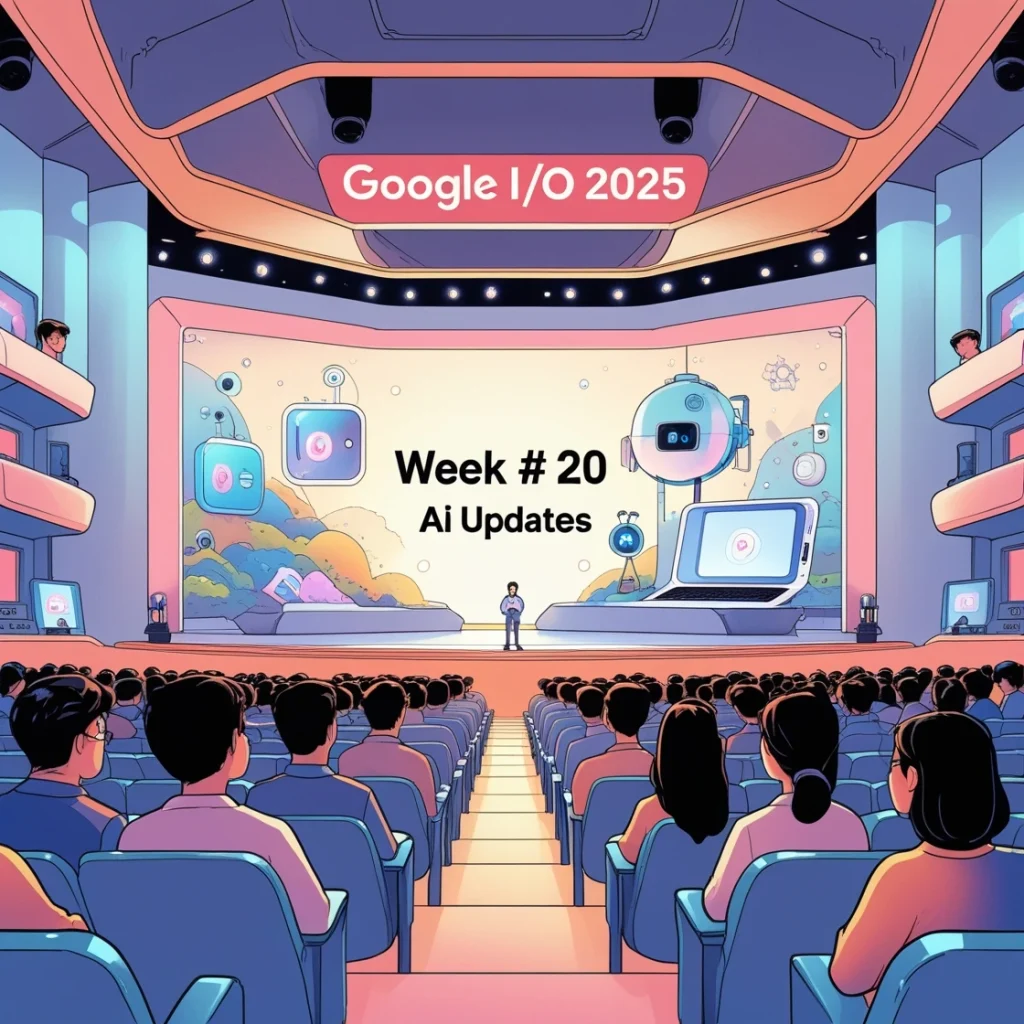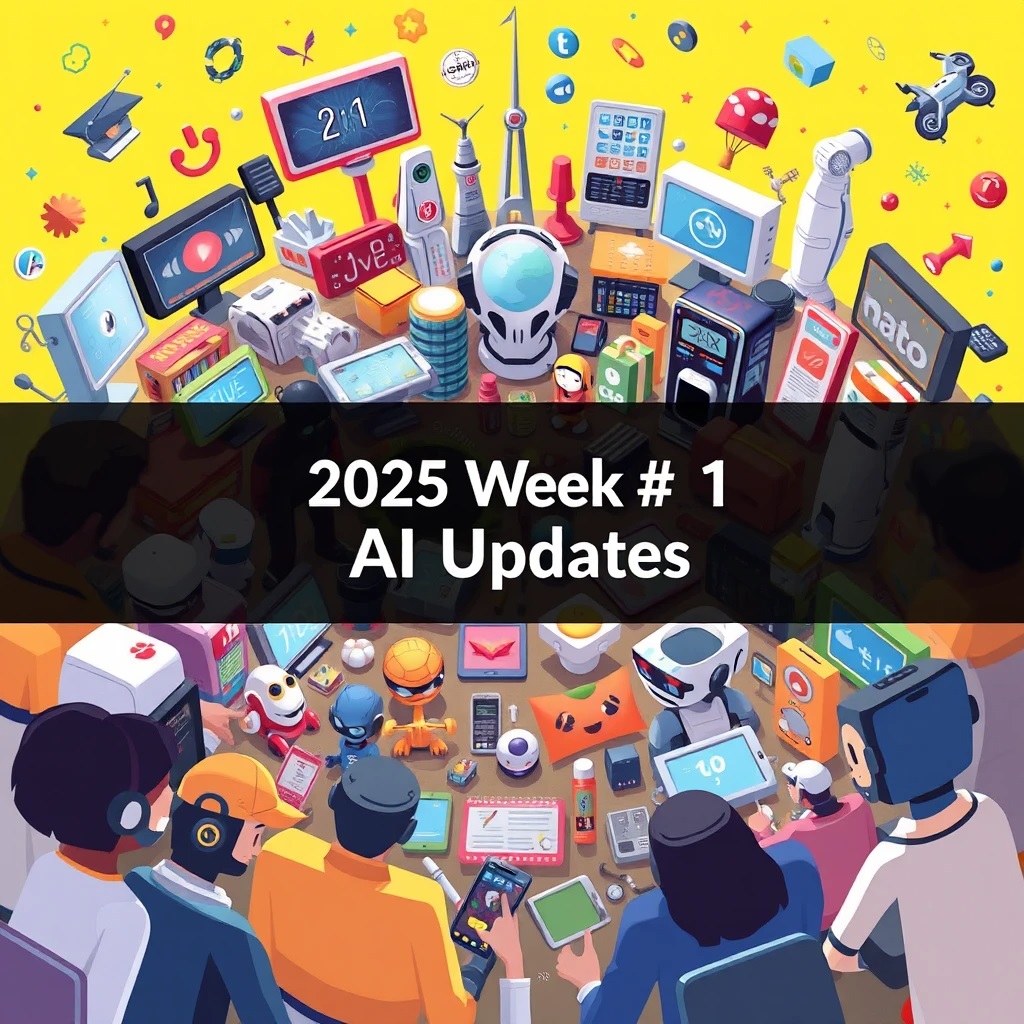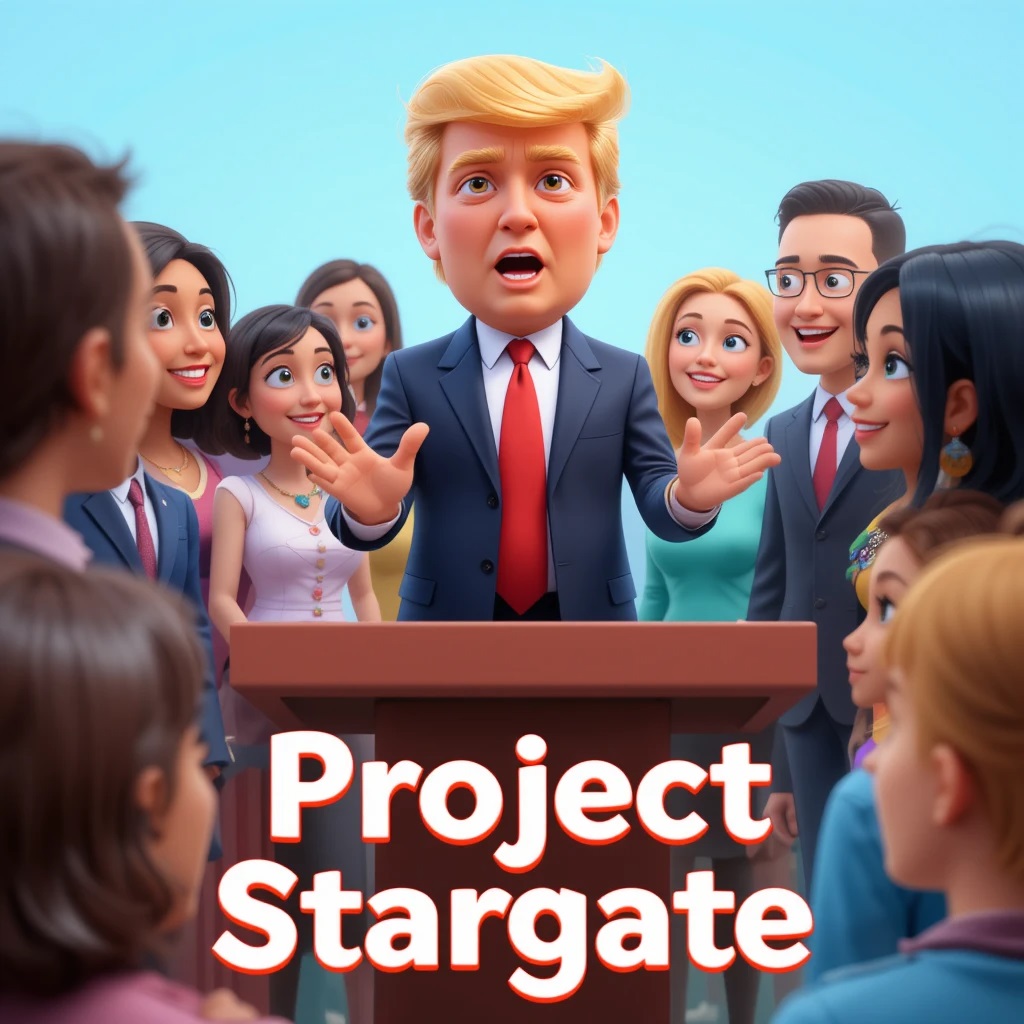Last Updated on May 21, 2025 by Editor
Step into the future now or risk being left behind—AI Week # 20 (May 14–20, 2025) delivered a whirlwind of groundbreaking innovations, massive funding rounds, and strategic industry moves that are reshaping the AI landscape at lightning speed. From Google’s powerful Gemini 2.5 Pro launch and AI-powered video tools to OpenAI’s GPT-4.1 integration into ChatGPT, and from Cohere’s acquisition of OttoGrid to Firecrawl’s bold $1 million experiment hiring AI agents as employees, this week was packed with game-changing developments. Major players like AMD divested $3 billion in server manufacturing to double down on AI chip design, while startups like Moonvalley and Hedra secured tens of millions in funding to push AI creativity and content generation forward. Meanwhile, legislative milestones like the U.S. criminalization of revenge porn and explicit deepfakes highlighted the urgent need for AI ethics and regulation. If you want to stay ahead in the fast-evolving world of artificial intelligence, this comprehensive roundup is your essential guide to the latest breakthroughs, investments, and industry shifts driving the AI revolution.
Google I/O 2025 Unleashes Next-Gen AI Capabilities
Google’s annual I/O developer conference in May 2025 showcased a formidable array of AI advancements designed to integrate more seamlessly into daily life. A significant highlight was the expansion of the Gemini AI platform, which now processes over 480 trillion tokens a month across Google products and APIs, a staggering 50-fold increase from the previous year. The Gemini app itself boasts over 400 million monthly active users, with a 45% increase in usage for the 2.5 Pro model. Key introductions include Gemini 2.5 Flash, now the default model offering lightning-fast responses, and Gemini 2.5 Pro’s Deep Think mode, an enhanced reasoning capability leveraging parallel thinking techniques, achieving impressive scores on complex benchmarks like 2025 USAMO for math.
Furthering its commitment to universal AI assistants, Google unveiled updates to Project Astra, allowing Gemini Live to incorporate real-time camera and screen-sharing on Android and iOS devices, making interactions five times longer than text-based conversations. The conference also introduced Google Beam, the evolution of Project Starline, transforming 2D video streams into realistic 3D experiences for communication using a six-camera array and AI for near-perfect head tracking at 60 frames per second. For creative professionals, Imagen 4 and Veo 3 were launched; Imagen 4 delivers superior image quality with improved text rendering, while Veo 3, Google’s state-of-the-art video generation model, is the first to natively support sound effects, background noises, and character dialogue. These tools are integral to Flow, a new AI filmmaking tool. Additionally, AI Mode is rolling out to all U.S. Google Search users, offering more advanced reasoning for complex queries and leveraging a custom version of Gemini 2.5. Google also announced the Google AI Ultra tier, a new premium subscription at $249.99/month for early and maximum access to bleeding-edge AI models and features.
Warby Parker and Google Forge $150M Partnership for AI Glasses
Warby Parker’s shares surged by 17.4% to 17.8% following the announcement of a strategic partnership with Google, focused on developing AI-powered eyewear designed for all-day wear. Google has committed up to $150 million to this venture, with an initial $75 million specifically allocated for product development and commercialization. An additional $75 million is slated as a potential equity investment in Warby Parker, contingent upon achieving certain milestones. This significant financial backing underscores Google’s long-term commitment to the collaboration, which marks the first eyewear partnership for Android XR, Google’s operating system for headsets and glasses.
This collaboration aims to blend Warby Parker’s acclaimed eyewear design expertise with Google’s advanced technological ecosystem. The companies anticipate launching their initial line of intelligent eyewear after 2025, which will feature both prescription and non-prescription lenses integrated with multimodal AI capabilities. Warby Parker, a direct-to-consumer lifestyle brand generating nearly $800 million in annual revenue with 14% year-over-year growth, is currently valued at approximately $2.1 billion. This partnership signals a bold stride into the next generation of computing, leveraging AI to provide real-time context and intelligence, revolutionizing how users interact with their environment.
Google Gemini App Elevates User Experience with Advanced AI
The Google Gemini app has received substantial updates, making it more personal, proactive, and powerful, with a strong focus on advanced AI capabilities. A major enhancement is the integration of real-time AI video through Veo 3, Google’s cutting-edge video generation model, which enables users to create 8-second videos with sound, including whimsical characters that speak, background music, and sound effects. This feature is currently available to Google AI Ultra subscribers in the U.S. Furthermore, the Deep Research feature has been significantly upgraded, allowing users to upload their own files and images as sources for reports. These detailed reports can then be transformed into interactive visuals, quizzes, and other engaging content within Canvas, making research more immersive.
The Gemini app now offers Gemini Live with camera and screen sharing for free on both Android and iOS, enabling users to point their phone at anything and discuss it in real-time, leading to conversations that are five times longer on average than text-based interactions. Personalized preferences can now be remembered by Gemini, leading to more helpful responses, and this feature is rolling out in over 40 languages. Students aged 18 and over in specific countries like Indonesia, Japan, the UK, and Brazil are eligible for a free upgrade to the Google AI Pro plan until July 2026, which includes access to NotebookLM and 2TB of free storage. These updates underscore Google’s commitment to rapidly iterating and bringing the best of Gemini to a wider audience, empowering users with more intuitive and comprehensive AI assistance.
Google Introduces AI-Powered Features for Discovery and Checkout
Google is transforming the online shopping experience with new AI-powered features designed to enhance discovery and streamline the checkout process. A key introduction is the new AI Mode in Google Search for shopping, which leverages Gemini capabilities and Google’s extensive Shopping Graph, containing over 50 billion product listings. This mode helps users browse for inspiration, consider options, and narrow down product choices with smart guidance. For instance, if a user searches for a “cute travel bag,” AI Mode can perform a “query fan-out,” conducting multiple simultaneous searches to identify criteria like suitability for rainy weather or long journeys, then suggesting relevant waterproof options. The right-hand panel in AI Mode dynamically updates with personalized product listings and images, facilitating discovery.
Furthermore, Google is introducing an agentic checkout feature named “buy for me,” which simplifies purchasing once a decision is made. Users can tap “track price” on any product listing, set preferred options like size and color, and specify their desired spending amount. Upon a price drop notification, users can confirm the purchase details, and Google will automatically add the item to the cart on the merchant’s site and securely complete the checkout via Google Pay. Another groundbreaking feature is the virtual try-on technology, which now allows shoppers to virtually try on billions of apparel listings by simply uploading their own photo. This technology is powered by a new custom image generation model for fashion that understands the human body and nuances of clothing materials, ensuring accurate virtual depictions. These new shopping features are rolling out to AI Mode users in the U.S. in the coming months, while virtual try-on is available through Search Labs.
Google Debuts Flow, an Advanced AI Filmmaking Tool
Google has officially launched Flow, an innovative AI-powered filmmaking tool designed to streamline the creative process for storytellers. Announced during Google I/O 2025, Flow is built upon Google’s most advanced AI models: Veo 3 for video generation, Imagen 4 for image creation, and the Gemini large language model for intuitive prompting. This synergy allows users to explore ideas freely and produce cinematic clips with exceptional prompt adherence, realism, and adherence to physics. Flow evolves from the earlier Google Labs experiment, VideoFX, and introduces features like Camera Controls for precise camera motion and angles, Scenebuilder to seamlessly extend shots, and Asset Management for organizing creative elements. It also boasts “Flow TV,” a showcase of Veo-generated content with visible prompts for learning.
Flow is currently available to subscribers of Google’s premium AI plans in the U.S.: Google AI Pro users receive 100 video generations per month and key features, while Google AI Ultra subscribers get the highest usage limits and early access to Veo 3 with native audio generation, including environmental sounds and character dialogue. Google emphasizes its collaborative approach, working with filmmakers like Henry Daubrez and Junie Lau to integrate their insights into the tool, aiming to empower a new wave of diverse storytellers by making advanced video creation more accessible.
Imagen 4 Elevates AI Image Generation with Unprecedented Detail
Google has unveiled Imagen 4, its latest and most advanced AI image generator, promising a significant leap in visual quality and capabilities. This new model is designed to produce stunning images with remarkable clarity in fine details, excelling in rendering intricate fabrics, water droplets, and animal fur. A key improvement in Imagen 4 is its ability to handle text within images with a new level of accuracy in spelling and typography, making it highly suitable for creating posters, greeting cards, and other visual content requiring legible text. The model now supports up to 2K resolution, enabling larger and more detailed image outputs suitable for various applications.
Imagen 4 is being integrated across Google’s ecosystem, including the Gemini app, Vertex AI, Whisk, and various Workspace tools such as Docs, Slides, and Vids, making its powerful generation capabilities widely accessible. Google also announced that a faster variant of Imagen 4, capable of generating images up to 10 times quicker than its predecessor, Imagen 3, will be released soon for rapid prototyping. This continuous innovation in generative AI reinforces Google’s commitment to providing cutting-edge tools for creative professionals and everyday users alike, pushing the boundaries of what’s possible with text-to-image technology.
Google Workspace Integrates New AI Features Across Gmail, Docs, and Vids
Google is significantly enhancing its Workspace applications with a suite of new AI features, leveraging the power of Gemini to boost productivity and personalize user experiences across Gmail, Docs, and Vids. For Gmail, new capabilities include Personalized Smart Replies that adapt to individual writing styles and tone, and Inbox Cleanup, which allows users to conversationally prompt Gemini to organize or delete emails based on specific criteria (e.g., “Delete all unread emails from The Groomed Paw from last year”). Additionally, Gemini in Gmail now helps with Calendar appointment scheduling, streamlining meeting coordination.
In Google Docs, users can now ground Gemini’s responses to specific, linked documents within Google Drive, ensuring source-grounded writing. The powerful Imagen 4 image generation model is also being integrated, allowing for richer, more detailed visuals directly within Docs, Slides, and other Workspace products. Google Vids, the AI-powered video creation app, receives substantial updates including AI Avatars (coming to Labs in June) that can speak uploaded scripts with accurate lip-syncing, eliminating the need for users to appear on camera. Other Vids enhancements include Transcript Trim to remove filler words and pauses, and Balance Sound to normalize audio levels across a video. These features, many of which are generally available or rolling out to Google AI Pro and Ultra subscribers, are designed to make work more efficient and creative.
Trump Signs Landmark Bill Criminalizing Revenge Porn and Explicit Deepfakes
In a bipartisan effort to combat online exploitation, President Donald Trump signed the “Take It Down Act” into law on May 20, 2025. This landmark federal bill criminalizes the non-consensual publication of intimate images, including digitally altered AI-generated “deepfakes”. The legislation received overwhelming support in Congress, passing the House by a 409-2 vote and clearing the Senate by unanimous consent, highlighting a strong consensus on the urgent need for such protections. The new law makes it a federal crime to “knowingly publish” or threaten to publish such content, with offenders facing fines, jail time, and restitution.
A crucial aspect of the “Take It Down Act” is its mandate for social media companies and online platforms to remove flagged content within 48 hours of a victim’s request. Furthermore, these platforms are required to take proactive steps to prevent the re-uploading of the same content, addressing the persistent issue of viral re-victimization. First Lady Melania Trump was a key advocate for the bill, emphasizing the “heartbreaking” impact of malicious online content, especially deepfakes, on young people. While many states already have laws against revenge porn, this federal legislation provides a uniform and comprehensive legal framework to protect victims nationwide, setting a precedent for holding both perpetrators and online platforms accountable in the evolving digital landscape.
AMD Divests ZT Systems Server Manufacturing Business for $3 Billion
Advanced Micro Devices (AMD) has announced a definitive agreement to sell the server manufacturing business of its recently acquired ZT Systems to Sanmina for approximately $3 billion in cash and stock. This deal, announced on May 19, 2025, includes a $2.25 billion upfront cash payment, a $300 million premium (split 50% cash and 50% equity), and a contingent payment of up to $450 million based on the business’s financial performance over the next three years. AMD had initially acquired ZT Systems for $4.9 billion in March 2025, with an announced intention to divest the manufacturing arm. This strategic move allows AMD to retain ZT Systems’ crucial AI systems design and customer enablement teams, focusing on its core strength in AI chip and rack-scale AI solution development.
The transaction positions Sanmina as a preferred new product introduction (NPI) manufacturing partner for AMD’s cloud rack and cluster-scale AI solutions, strengthening AMD’s U.S.-based manufacturing capabilities. The deal is expected to close near the end of 2025, subject to regulatory approvals. According to AMD’s executive vice president Forrest Norrod, this partnership will accelerate the quality and time-to-market for their cloud customers. While AMD shares were down around 2.7% in premarket trading following the news, the company aims to onshore more of its supply chain, with flagship chips also now being manufactured at TSMC’s new Arizona site. For Sanmina, this acquisition is expected to strengthen its position in the expanding cloud and AI markets, potentially doubling its revenue within three years.
xAI’s Grok-3 Models Now Available on Microsoft Azure
Elon Musk’s xAI has announced a significant partnership with Microsoft, making its cutting-edge Grok-3 and Grok-3 Mini large language models available to developers via Microsoft Azure AI Foundry. This move, revealed on May 20, 2025, at Microsoft’s Build developer conference, marks a pivotal expansion of Azure’s diverse AI model offerings, which now total over 1,900 variants from various creators. The integration of Grok-3 provides Azure users with access to xAI’s models known for their advanced reasoning, coding, and visual processing capabilities, enabling enterprises to build sophisticated AI applications in a secure, scalable environment.
This collaboration is strategic for both companies. For xAI, it provides direct access to hundreds of thousands of potential enterprise customers and their feedback, accelerating the adoption and refinement of Grok. For Microsoft, it reinforces Azure’s position as a leading, open platform for AI development, offering a wider choice to developers and potentially intensifying its competition with other cloud providers and even its long-time partner OpenAI. Despite past controversies surrounding Grok’s unfiltered responses, Microsoft is providing its standard service-level agreements and handling billing directly, ensuring a seamless experience for developers. This partnership underscores the rapidly evolving landscape of AI cloud services, where platform openness and model diversity are becoming key differentiators.
Y Combinator Startup Firecrawl Seeks AI Agents with $1M Budget
Firecrawl, a Y Combinator-backed startup specializing in an open-source web crawler that transforms websites into large language model (LLM)-ready data, is making headlines by seeking to hire three autonomous AI agents as “employees” with a dedicated $1 million budget. Announced on May 17, 2025, this unconventional hiring strategy highlights the company’s experimental approach to the future of work. Firecrawl is looking for an AI Content Creation Agent, a Customer Support Engineer Agent, and a Junior Developer Agent, each offering a monthly compensation of $5,000. The “salary” for these AI roles is intended for the human developers or startups capable of building and maintaining these self-sufficient AI systems, rather than the AI itself.
Founder Caleb Peffer clarified that while previous attempts to hire AI agents fell short, the current initiative is a serious push to find “incredible AI engineers” capable of creating these autonomous entities. The content creation agent, for example, must autonomously generate SEO-optimized blog posts, track user engagement, and continuously improve performance. The junior developer AI is expected to handle GitHub issues and code in TypeScript and Go. Firecrawl’s business model revolves around providing clean, structured web data for AI agents, and its job listings underscore the evolving landscape of AI-driven automation. Despite the provocative nature of the job descriptions, Firecrawl’s true objective is to recruit the human talent essential for developing AI systems that can scale human skills through automation, generating significant industry buzz, including 19,000 GitHub stars in just six months.
AI Leader Cohere Acquires Ottogrid for Enhanced Market Research
Leading AI startup Cohere has acquired Ottogrid, a Vancouver-based platform specializing in AI-powered market research tools. The acquisition, which was announced on May 16, 2025, for an undisclosed sum, signifies Cohere’s strategic intent to bolster its enterprise offerings and automate complex primary market research processes. Ottogrid, initially founded as Cognosys in 2023 by Omar Sully and Homam Malkawi, had previously raised approximately $2 million in venture capital from investors including GV (Google Ventures) and Cohere’s co-founders Ivan Zhang and Aidan Gomez.
Following the acquisition, Ottogrid’s standalone product will be discontinued, with its features and team integrating into Cohere’s platforms. Specifically, Ottogrid’s technology, known for its “native table interface” capable of extracting and analyzing structured data from websites and other sources, will be integrated into Cohere’s North platform. North is Cohere’s ChatGPT-style AI assistant focused on document analysis, knowledge work, and streamlining research-intensive workflows for enterprise clients. This acquisition aligns with Cohere’s recent strategic pivot towards private AI deployments for specific sectors like healthcare, finance, and government, following a reported shortfall in its 2023 revenue targets by 85%. However, Cohere has since announced that its annualized revenue has reached $100 million, indicating a successful adjustment in strategy. The integration of Ottogrid is expected to significantly enhance Cohere’s ability to provide automated workflows, enrich data, and scale operations for its growing enterprise clientele.
AI Video Startup Moonvalley Lands $53 Million in New Funding
Moonvalley, a Los Angeles-based AI video generation startup, has secured an additional $53 million in funding, according to a recent SEC filing on May 16, 2025. This latest injection of capital, sourced from 14 unnamed investors, includes a fresh $10 million on top of a $43 million round announced just a month prior. With this new investment, Moonvalley’s total funding has surged to an impressive $124 million, according to Pitchbook estimates. This rapidly accumulating capital highlights significant investor confidence in Moonvalley’s advanced tools for video production.
The company had previously raised a substantial $70 million seed round in November 2024, led by prominent investors such as General Catalyst, Khosla Ventures, and Bessemer Venture Partners. Moonvalley has gained recognition for its focus on safe and legal AI video creation, working with partners to manage licensing arrangements and compile videos into datasets that the company then purchases for training its models. This approach is similar to that of other industry players like Pika and Adobe. The funds will further support the development of Moonvalley’s “Marey” model, an AI video generation tool built in collaboration with animation studio Asteria, offering users precise control over camera angles and motion, as well as HD clip generation up to 30 seconds long.
Hedra Raises $32 Million from a16z for Advanced Video Avatars
Hedra, an AI video generation startup known for powering viral content like “talking baby podcasts,” has successfully closed a $32 million Series A funding round. The investment, announced on May 15, 2025, was led by Andreessen Horowitz’s (a16z) Infrastructure fund, valuing the company at $200 million. This round brings Hedra’s total raised capital to $43 million, following earlier investments from existing participants including a16z Speedrun, Abstract, and Index Ventures. Matt Bornstein from Andreessen Horowitz will join Hedra’s board of directors as part of the deal.
At the core of Hedra’s platform is Character-3, an innovative omnimodal AI model that processes and reasons across image, text, and audio inputs, enabling the creation of lifelike digital personas with natural expressions. The technology underpins Hedra Studio, a web-based video generation and editing suite that supports high-quality video production, full-body expressions with emotional control, dynamic environments, and style transfers. Launched in 2023, Hedra has already attracted over 3 million users and powered more than 10 million videos. The company plans to triple its current 20-person team by the end of 2025 and invest in infrastructure to scale video rendering capabilities, aiming to revolutionize enterprise marketing by making high-quality video production more accessible and cost-effective.
OpenAI Integrates Advanced GPT-4.1 Models for Enhanced Performance
OpenAI has begun rolling out its more advanced GPT-4.1 and GPT-4.1 Mini models directly into ChatGPT, significantly enhancing the chatbot’s capabilities, particularly for paid subscribers. Announced on May 14, 2025, these models were previously available only via the API, but are now accessible to ChatGPT Plus, Pro, and Team users through the model picker menu. For free-tier users, GPT-4.1 Mini will replace GPT-4o Mini, elevating the overall intelligence baseline for all users. These successors to the 4o series models bring major gains in coding, instruction following, and long-context comprehension, boasting context windows of up to 1 million tokens.
The GPT-4.1 models notably outperform GPT-4o across various benchmarks. For instance, GPT-4.1 is significantly better at coding tasks, achieving a 54.6% completion rate on the SWE-bench Verified benchmark (compared to 33.2% for GPT-4o) and improving frontend coding. It also shows enhanced reliability in instruction following, scoring 38.3% on the MultiChallenge benchmark. The GPT-4.1 Mini model offers a “significant leap” in small model performance, even surpassing GPT-4o in many intelligence evaluations while reducing latency by nearly half and cutting costs by 83%. These advancements aim to make ChatGPT more powerful and efficient for complex tasks, especially for developers and enterprise users.
TensorWave Secures $100 Million for AMD-Powered Cloud
TensorWave, a rapidly emerging leader in AI infrastructure solutions, has announced it raised $100 million in Series A funding on May 14, 2025. This significant investment is co-led by Magnetar and AMD Ventures, with additional participation from Prosperity7, Maverick Silicon, and Nexus Venture Partners. The funding builds upon TensorWave’s earlier $43 million SAFE (Simple Agreement for Future Equity) funding round which closed in October 2024, bringing its total raised capital to $143 million. The capital infusion is set to accelerate the deployment of what the company calls the world’s largest liquid-cooled AMD GPU cluster, featuring 8,192 Instinct MI325X GPUs.
This massive cluster is specifically designed for high-density, high-throughput training and fine-tuning of large-scale AI models, addressing the critical infrastructure bottleneck faced by the burgeoning AI market. TensorWave, founded in 2023 and based in Las Vegas, provides companies with access to AI compute availability via AMD Instinct GPUs. The new funding will support operational growth, team expansion, and further development of its AI solutions powered by AMD technology. The company projects to close 2025 with an impressive revenue run rate exceeding $100 million, representing a 20x year-over-year increase. This substantial investment underscores the increasing demand for specialized AI computing resources and positions TensorWave as a key player in the evolving AI infrastructure ecosystem, particularly for those seeking alternatives to NVIDIA-dominated cloud offerings.
As AI continues to evolve at an unprecedented pace, staying informed is your key to unlocking tomorrow’s opportunities today. Don’t miss out on next week’s AI Week # 21 roundup, where we’ll bring you the latest breakthroughs, funding news, and industry shifts shaping the future of artificial intelligence. Subscribe now and be the first to know what’s next in the AI revolution!




